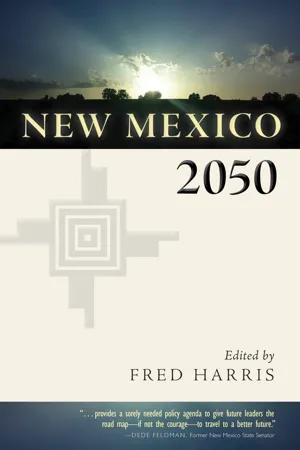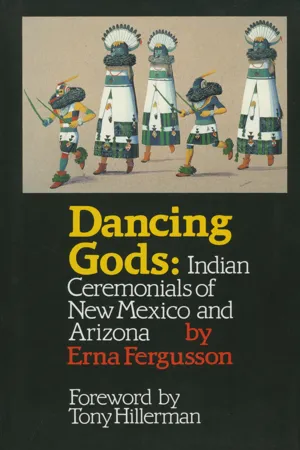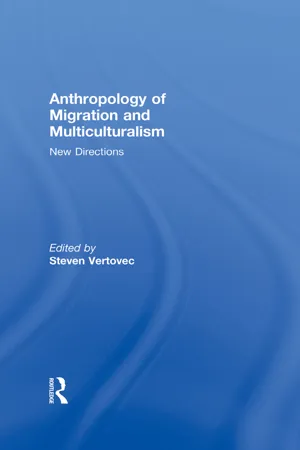History
Navajo Tribe
The Navajo Tribe is a Native American tribe known for their rich history and culture, including their traditional art, weaving, and jewelry. They have a strong connection to the land and are known for their skilled horsemanship. The tribe has a complex history, including their forced relocation by the U.S. government in the 1860s known as the "Long Walk."
Written by Perlego with AI-assistance
Related key terms
7 Key excerpts on "Navajo Tribe"
- eBook - ePub
Indigenous Peoples and Globalization
Resistance and Revitalization
- Thomas D. Hall, James V. Fenelon(Authors)
- 2015(Publication Date)
- Routledge(Publisher)
Revitalization and resistance go hand in hand with these modern-day images, reflecting American social institutional structures of higher education, even as it is contrasted and enhanced with traditional Lakota value systems. This entire set of constructions—college, Standing Rock reservation as a “nation,” indigenous history and knowledge alongside contemporary Western versions of the world, and imagery of respect for Lakota society—exists solely because of sovereignty. Traditionalists resisted full incorporation for nearly 200 years and maintained Lakota social structures even as they adapted to the dominance of contemporary American society. In this way, cultural and political forms of sovereignty intersect. Without the political recognition, under constant perusal by legal interpretations but ultimately providing constrained claim to limited “tribal sovereignty,” there would likely be no Sitting Bull College. But just as true, without the struggle over cultural practices and belief systems, under constant attack by the dominant U.S. society, and with a constant defense by many traditionalists as seen in revitalizing the SunDance, there would likely be no Lakota traditions to honor and show respect, and thus revitalize the Lakota people.Plate 5.5. Eagle feather headdress displayed at Sitting Bull College on Standing Rock, demonstrating traditional and modern forms of learning and knowledge. (Photo courtesy of James V. Fenelon)We will now discuss another remarkable struggle of an “Indian nation” or indigenous people in a very different social and geographic setting, and over different time periods, but with similar results.THE AMERICAN SOUTHWEST AND THE NAVAJO PEOPLES 17
Navajo, or Diné, people originated hundreds if not thousands of years ago and took part in ancient movements across the Americas; they are related to people in Canada by the same name. They settled in their current lands after living on the central plains of North America and founded the Navajo nation with strong connections to the land, bounded by four sacred mountains. American people became familiar with the Navajos sometime in the nineteenth century, after the Santa Fe Trail opened in 1821, and more so after the Mexican-American War (1846–1848), after which the United States annexed the northern half of Mexico and gained control of what would become Texas, New Mexico, Arizona, California, and parts of Nevada, Utah, Colorado, and Oklahoma (Reséndez 2005 ). However, by that time Navajos had been in contact with Spanish people for nearly three centuries. Spaniards first entered the region in 1536 when Cabeza de Vaca traversed the territory in a journey to Mexico City after he was shipwrecked somewhere along the Gulf Coast of what is now Texas. Francisco de Coronado explored the region in 1540–1542. Don Juan de Oñate led the first colonizing expedition to what we now know as Santa Fe, New Mexico, in 1598,18 - eBook - ePub
- Fred Harris, Fred Harris(Authors)
- 2015(Publication Date)
- University of New Mexico Press(Publisher)
Disputes over the extent and exact boundaries of these Pueblo lands continued well into the late twentieth century, however. Today the nineteen remaining New Mexico Pueblo tribes continue to occupy the lands and villages where the Spaniards encountered them almost five hundred years ago and are governed largely by their ancient traditions, although a few of them have adopted constitutional forms of government, as authorized by U.S. federal law in 1934. The executive duties are discharged by a governor and lieutenant governor, assisted and guided by tribal councils that are either elected or appointed by traditional leaders.Navajo Nation
While the Spanish, Mexican, and American authorities claimed to recognize the rights of Pueblo tribes to the lands they occupied and farmed, the same could not be said for the rights of the Navajo and Apache tribes within what is now New Mexico. Long before any European set foot in the Americas, the Navajo people, the Diné, defined their homeland as that territory bounded by four sacred mountains. Mount Blanca (Dawn or White Shell Mountain) near Alamosa, Colorado, defines the eastern boundary. Mount Taylor (Blue Bead Mountain), north of Laguna, New Mexico, delineates the southern boundary. The San Francisco Peaks (Abalone Shell Mountain) near Flagstaff, Arizona, mark the westernmost edge of Dinetha. Mount Hesperus (Big Mountain Sheep) in the La Plata range of the Colorado Rocky Mountains anchors the northern boundary.5The Diné have been in the southwestern United States since they migrated south from western Canada around 1300 AD. The Navajos resisted Spanish and Mexican domination prior to 1848 and waged defensive wars against U.S. attempts at subjugation following the Mexican-American War. In 1864, following a literal scorched earth campaign, the U.S. military succeeded in bringing the Navajos under submission and forcibly deported them from their homeland to Bosque Redondo, near Fort Sumner, New Mexico, in the Pecos River Valley. More than two hundred Navajos perished on the “Long Walk” there, and the Bosque Redondo area was neither suitable nor adequate to sustain their numbers. - eBook - ePub
Working the Navajo Way
Labor and Culture in the Twentieth Century
- Colleen O'Neill(Author)
- 2005(Publication Date)
- University Press of Kansas(Publisher)
5These mountains embody tremendous power for the Diné. They provide the stories, life lessons, and values that are central to their culture. As respected elder and storyteller George Blueeyes described, “This is how they sit for us. / We adorn ourselves just as they do, / With bracelets of turquoise, / And precious jewels about your necks.” They mark the places that signify Diné origins and reaffirm their cultural identity. As Mr. Blueeyes continued,“These mountains and the land between them / Are the only things that keep us strong. / From them, and because of them we prosper. / It is because of them that we eat plants and / good meat.”6Today, each of the four sacred mountains lies beyond the political boundaries of the Navajo Reservation, which encompasses 25 ,000 square miles, crossing the borders of Arizona, New Mexico, and Utah and is often compared in size to the state of West Virginia. In 1930 , the Navajo population numbered between 39 ,000 and 40 ,000 people. A generation later, by 1960 , that number increased to 60 ,000 .7 By 1972 , over 120 ,000 people lived on the Navajo Reservation. Today, the Navajo nation is one of the largest American Indian communities in the United States, and its reservation is one of only a few that encompass ancestral lands.Map 1.1. Diné Bikéyah. Map drawn by Jorge Lizárraga.Diné Bikéyah, the Navajo homeland, is spectacular and varied terrain. In the mid-1940 s, the noted anthropologists Clyde Kluckhohn and Dorothea Leighton attempted to describe its totality, likening it to a massive landscape painting. They encouraged their readers to imagine “the sagebrush interspersed with groves of small evergreens . . . against a background of highly colored mesas, canyons, buttes, volcanic necks and igneous mountain masses clothed in deep pine green, [and] roofed over with a brilliant blue sky.”8 In 1982 - eBook - ePub
Music around the World
A Global Encyclopedia [3 volumes]
- Andrew R. Martin, Matthew Mihalka Ph.D., Andrew R. Martin, Matthew Mihalka Ph.D., Andrew R. Martin, Matthew Mihalka Ph.D.(Authors)
- 2020(Publication Date)
- ABC-CLIO(Publisher)
Land of the Spotted Eagle . Lincoln: University of Nebraska Press.Troutman, John William. 2009. Indian Blues: American Indians and the Politics of Music, 1879–1934 . Norman: University of Oklahoma Press.Navajo, Music ofThe Navajo are a Native American people descended from Athapaskan-speaking hunters, gatherers, and raiders who entered the American Southwest from Canada between 900–1200 CE. Navajo creation stories and songs locate the people between four sacred mountains: Sierra Blanca Peak (Dawn or White Shell Mountain) on the east, Mount Taylor (Blue Bead or Turquoise Mountain) on the south, the San Francisco Peaks (Abalone Shell Mountain or Yellow Mountain) on the west, and La Planta Mountain (Obsidian Mountain or Black Mountain) on the north.Seventeenth-century Spaniards such as the Franciscan friar Benavides called the Navajo Apaches de Nabajó (large planted fields) and the nearby Tewa-speaking peoples used the word navahu to mean either “large cultivated lands,” or “to take from the fields.” The neighboring Zuñ i and Hopi called them the Tasuvah (head pounders), and the Navajo call themselves the Diné (the People). The Diné were more fortunate than many Native peoples: after their incarceration at Fort Sumner from 1864 to 1868, they were allowed to return to part of their traditional homeland. Washington Matthews, an army surgeon stationed in Navajo country in the 1880s and 1890s, was the first to publish detailed reports on Navajo arts, music, philosophy, and cosmology.The modern Navajo Nation is situated on 24,000 square miles of southern Utah, northern Arizona, and a “checkerboard” region in northwestern New Mexico. The local economy depends to a small extent on farming and raising livestock, and to a larger extent on mining and timber harvesting. Traditional arts such as turquoise work, silversmithing, weaving, and song contests now drive tourism. Music featured in public cultural performances tends to emphasize the shorter, but more spectacular, curing chantways, with their prayer sticks, sand paintings, and body paint. - eBook - ePub
Therapeutic Interventions with Ethnic Elders
Health and Social Issues
- Sara Aleman, Tanya Fitzpatrick, Thanh V Tran, Elizabeth Gonzalez, Sara Aleman, Tanya Fitzpatrick, Thanh V Tran, Elizabeth Gonzalez(Authors)
- 2014(Publication Date)
- Routledge(Publisher)
The history of the Indian Health Service (IHS) is also presented in this chapter. This is of paramount importance because the IHS delivers health services based on the Western medical model to the Navajo, and the majority of professionals are non-Native. The importance of evaluating health care from the perspective of those who are treated cannot be emphasized enough when looking at the Navajo elder. The room for misunderstanding between elders and the predominantly non-Native medical staff employed by IHS is great. These are people from two different worlds who are separated by language, culture, religion, and way of life.The following is a brief historical backdrop for understanding the history between the Diné and the United States government, which has fundamentally defined how many Diné elders deal with systems and individuals that are supposed to provide services to them and their families.The Diné
The Diné, a nomadic people and part of the NaDene language group, have language relatives in Alaska, Canada, Washington, Oregon, and California. Part of the Athabaskan ethnic group (Downs, 1972; Wood, Vannette, and Andrews, 1982), the Diné are centered in Arizona and New Mexico but can also be found in numbers over 1,000 in California, Colorado, Texas, and Utah. In 1990, 212,000 Diné registered with the Navajo Tribe and they made up 11.7 percent of the total American Indian population (U.S. Census Bureau, 1992). The majority of tribal members live on the Navajo Reservation, which consists of 27,000 square miles and spans the three states of Arizona, New Mexico, and Utah.As a colonized minority group, the Navajo have been assigned the curious position of outsiders in their own world. Effects of colonization in the form of boarding schools, hospitals, and churches have taken their toll on the Navajo people. Despite many difficulties, however, the Navajo have survived, and to understand where they are today, one must understand where they came from.The Beginning
The Navajo people believe in the four-world structure. The worlds are described as the black, blue, yellow, and white or glittering world. The First World was black, and four holy beings were created to run this new world. These holy beings were Water Monster, Blue Heron, Frog, and Lightning. These leaders were to govern the people in positive ways in order to promote good moral character and to prevent adultery and incest from occurring among the people. - eBook - ePub
Dancing Gods
Indian Ceremonials of New Mexico and Arizona
- Erna Fergusson(Author)
- 1988(Publication Date)
- University of New Mexico Press(Publisher)
In appearance they are very different from the other southwestern Indians. One would say, offhand, that Navajos are a tall people, slim-waisted, both men and women, with high cheek-bones, narrow hands and feet. Yet on closer acquaintance they are seen to represent every human type. They are short and fat as well as long and lean; high aquiline noses and narrow faces are varied by flat faces and almost Negroid features. Probably Jewish traders could contribute little to the Navajo’s gift as a hard and close dealer, but Jewish features are not infrequent. A stunning sheik of the desert may have gray eyes; they are probably due to the fact that the American Army passed that way. Whatever his physical appearance, the Navajo’s outstanding characteristic is his hauteur. He is dignified to the point of superciliousness; and he looks upon the white man as upon a strange interloper whom he tolerates because it is his own high pleasure to do so, and not because he has to. That the Navajos consider themselves the aristocrats of the southwest they tacitly admit by calling themselves “Dinne,” the People. They are of Athapascan stock, and ethnologists are generally agreed that they came from the north, drifting into the area they now occupy less than a thousand years ago. In earliest historical times they were found wandering over what is now western New Mexico, eastern Arizona, and southern Utah and Colorado. Their present reservation, while much smaller than their original range, is in the same region. Navajo legends in general bear out the supposition that they came from the north, except one very picturesque one which tells that the People came from the south, bringing their four sacred plants: tobacco, corn, squash, and beans. They occupied all the country, but, finding the Pueblo people better fitted for agriculture, they generously gave them the valley lands and kept the high grassy uplands for themselves - eBook - ePub
Anthropology of Migration and Multiculturalism
New Directions
- Steven Vertovec(Author)
- 2013(Publication Date)
- Routledge(Publisher)
In some ways attention to culture evokes the old distinction between acculturation and assimilation where acculturation focuses on values, meanings, and symbols, while assimilation points to aspects of social organization (family, class, intermarriage, institutions) (Gans 1997). But as someone familiar with the use of these terms to describe the supposed rapid disappearance of Native American populations, I want to break with this framework. In spite of over 150 years of assimilationist government policy, Native American cultures did not disappear and, some might argue have in the past thirty years gone through a renaissance. Among Native American populations there has been renewed attention to federal recognition, cultural and linguistic revival, and historic preservation. There has also been cultural innovation in the arts and music. Pan-Indian events and religious practices: powwow dancing, the sweat lodge, the Sun Dance and Native American Church ceremonies have also increased in popularity. All this points to an increasing emphasis on cultural difference among Native Americans.In this analysis I shall focus on women, since they are often the centre of family networks and the support system for family-based ceremonies. I shall also evoke two forms of bricolage ‘weaving’ and ‘stirring’ that utilize Navajo women’s activities as metaphors for the construction of cultural difference and identity.The Navajo family in New MexicoLet me now turn to the Navajo. I argue that we need to see cultural and social processes in the context of changes in the Navajo political economy over the last forty years. I originally conducted field research for my PhD dissertation in 1965–66 in a small Navajo community on the eastern side of the Navajo reservation. In my book, I call this community Copper Canyon.At that time, the Navajo were already shifting away from a pastoral-agricultural economy. The reservation was being transformed through the increased exploitation of its mineral resources and the growth of tribal, state and federal bureaucratic structures (primarily schools, hospitals and government offices). In the mid-1960s, regional migration was encouraged by the boarding school system and the Bureau of Indian Affair’s re-location programme that sent Navajo families to distant cities. Those who remained on the reservation found themselves more dependent on welfare and wages. In my 1965 census, 25 per cent of the 1000 Copper Canyon community members were living off-reservation, many in Denver, Los Angeles and Albuquerque. Livestock, farming and weaving only contributed 14 per cent of community income, while wages (including seasonal work for the railroad) made up 50 per cent and welfare and social security 24 per cent. The remaining income came from Tribal works programmes.






